- Home
- Jack Kerouac
Atop an Underwood: Early Stories and Other Writings
Atop an Underwood: Early Stories and Other Writings Read online
Table of Contents
Title Page
Copyright Page
Dedication
Introduction
Part One - Pine Forests and Pure Thought 1936—1940
from Background
Repulsion May Race Here in Exhibition Feature!! Mighty Kerouac Gelding Would ...
from Football Novella
Jack Lewis’s Baseball Chatter
[One Long Strange Dream]
Count Basie’s Band Best in Land; Group Famous for “Solid” Swing
Go Back
Nothing
A Play I Want to Write
Concentration
We Thronged
[A Day in September]
[I Know I Am August]
Radio Script: The Spirit of ‘14
[I Remember the Days of My Youth]
from Raw Rookie Nerves
Where the Road Begins
New York Nite Club—
Part Two - An Original Kicker 1941
from Background
There’s Something About a Cigar
God
If I Were Wealthy
[One Sunday Afternoon in July]
The Birth of a Socialist
No Connection: A Novel That I Don’t Intend to Finish
On the Porch, Remembering
The Sandbank Sage
Farewell Song, Sweet from My Trees
[I Have to Pull Up My Stakes and Roll, Man]
Odyssey (Continued)
[At 18, I Suddenly Discovered the Delight of Rebellion]
Observations
Definition of a Poet
America in the Night
Woman Going to Hartford
Old Love-Light
I Tell You It Is October!
[Here I Am at Last with a Typewriter]
[Atop an Underwood: Introduction]
The Good Jobs
From Radio City to the Crown
... The Little Cottage by the Sea . . . .
The Juke-Box Is Saving America
... Hartford After Work . . . .
... Legends and Legends . . . .
. . . A Kerouac That Turned Out Sublime . . . .
The Father of My Father
Credo
... Hungry Young Writer’s Notebook . . . .
A Young Writer’s Notebook
[I Am Going to Stress a New Set of Values]
[I Am My Mother’s Son]
[Howdy!]
Today
This I Do Know—
Search by Night
Part Three - To Portray Life Accurately 1942–1943
from Background
Sadness at Six
The Joy of Duluoz
Famine for the Heart
[The Very Thing I Live For]
The Mystery
Thinking of Thomas Wolfe on a Winter’s Night
from The Sea Is My Brother (Merchant Mariner)
Beauty as a Lasting Truth
My Generation, My World
The Wound of Living
Wounded in Action
The Romanticist
The Boy from Philadelphia
The Two Americans
Acknowledgements
FOR THE BEST IN PAPERBACKS, LOOK FOR THE
Praise for Atop an Underwood:
Early Stories and Other Writings by Jack Kerouac
“Kerouac’s fans will be delighted with Atop an Underwood ... this is as broad a feast as any aficionado could hope for... what startles is how good Kid Kerouac was and how early he defined his themes . . . the beauty of Marion’s editorial contribution is that Atop an Underwood works as well for new readers of Kerouac as for knowledgeable devotees.”
—St. Petersburg Times
“Offers a wonderful glimpse into the author’s formative years. Editor Marion includes notes that illuminate certain sections without intrusion.”
—Boston Herald
“Fascinating to Kerouac scholars and surprisingly accessible to the novice reader . . . provides a poignant picture of a life brimming with promise.”
—The Boston Globe
“This is a Jack Kerouac developing his skills, awaiting his muse . . . there are flashes of brilliance, hints of things to come, passages to be underlined and read aloud to friends. Marion’s introductions are brief and to the point, intelligent and unpretentious.”
—The Cleveland Plain Dealer
“It’s good to dip into the early writings and see the confident, hopeful Jack Kerouac who was the source of his own dreams.”
—The Philadelphia Inquirer
“Marion has assembled a collection of Kerouac’s early work that is fascinating in what it reveals about his early interests and his early methods ... Keroauc’s intense desire to be a writer hit him early and stayed with him his entire life. This passion colors all of this early stuff . . . And his themes are all here: America, travel, jazz, the delicate presence of death ... the passion Kerouac brought to all of his writing is here.
—The American Book Review
“It should come as no surprise that Kerouac’s salient literary features—his Whitmanesque appetite for both experience and electrifying description, his love of motion and music, and his persistent autobiographical streak—are already present in his youthful work.” —ALA Booklist
PENGUIN BOOKS
ATOP AN UNDERWOOD
Paul Marion was born in Lowell, Massachusetts, in 1954. He is a graduate of the University of Massachusetts Lowell and has published several collections of poetry. His most recent book is French Class: French Canadian-American Writings on Identity, Culture and Place, of which he is the editor and a contributor. He lives in Lowell with his wife and son.
ALSO BY JACK KEROUAC
The Town and the City
On the Road
The Subterraneans
The Dharma Bums
Doctor Sax: Faust Part Three
Maggie Cassidy
Mexico City Blues
The Scripture of the Golden Eternity
Tristessa
Lonesome Traveler
Book of Dreams
Pull My Daisy
Big Sur
Visions of Gerard
Desolation Angels
Satori in Paris
Vanity of Duluoz: An
Adventurous Education, 1935—46
Scattered Poems
Pic
Visions of Cody
Heaven & Other Poems
Pomes All Sizes
Good Blonde & Others
Old Angel Midnight
The Portable Jack Kerouac
Selected Letters: 1940—1956
Book of Blues
Some of the Dharma
Selected Letters: 1957—1969
Orpheus Emerged
Book of Haikus
PENGUIN BOOKS
Published by the Penguin Group
Penguin Group (USA) Inc., 375 Hudson Street, New York, New York 10014, U.S.A.
Penguin Group (Canada), 10 Alcorn Avenue, Toronto,
Ontario, Canada M4V 3B2 (a division of Pearson Penguin Canada Inc.)
Penguin Books Ltd, 80 Strand, London WC2R ORL, England
Penguin Ireland, 25 St Stephen’s Green, Dublin 2, Ireland (a division of Penguin Books Ltd)
Penguin Group (Australia), 250 Camberwell Road, Camberwell,
Victoria 3124, Australia (a division of Pearson Australia Group Pty Ltd)
Penguin Books India Pvt Ltd, 11 Community Centre,
Panchsheel Park, New Delhi—110 017, India
Penguin Group (NZ), cnr Airborne and Rosedale Roads,
Albany, Auckl
and, New Zealand (a division of Pearson New Zealand Ltd)
Penguin Books (South Africa) (Pty) Ltd, 24 Sturdee Avenue,
Rosebank, Johannesburg 2196, South Africa
Penguin Books Ltd, Registered Offices: 80 Strand, London WC2R ORL, England
First published in the United States of America by Viking Penguin,
a member of Penguin Putnam Inc. 1999
Published in Penguin Books 2000
Copyright © the Estate of Stella Kerouac,
John Sampas, Literary Representative, 1999
Introduction and commentary copyright © Paul Marion, 1999
All rights reserved
“Count Basie’s Band Best in Land; Group Famous for ‘Solid’ Swing”
first appeared in The Horace Mann Record, February 16, 1940.
Grateful aknowledgment is made for permission to reprint excerpts
from “Blues in the Night” by Johnny Mercer and Harold Arlen.
© 1941 (renewed) Warner Bros. Inc. All rights reserved. Used by
permission. Warner Bros. Publications U.S. Inc., Miami, Florida.
ISBN : 978-1-101-55062-5
1. Beat generation—Literary collections. I. Marion, Paul.
1954—II. Title.
PS3521.E735A—20052
813’.54—dc21
http://us.penguingroup.com
To young writers everywhere
As I am, so I see.
—Ralph Waldo Emerson
Are you he who would assume a place to teach or be a poet here in
the States? The place is august, the terms obdurate.
—Walt Whitman
Always considered writing my duty on earth.
—Jack Kerouac
Introduction
When Jack Kerouac burst on to the American scene in 1957 with his Roman candle book On the Road, he had been a writer for more than twenty years. He later defined what it means to be a born writer: “When the question is therefore asked, ‘Are writers made or born?’ one should first ask, ‘Do you mean writers with talent or writers with originality?’ Because anybody can write, but not everybody invents new forms of writing.” The clarification was rooted in his understanding of the word genius as meaning “to beget.” Along with creating more than twenty books, Kerouac knew he had invented a new way of writing, fusing local talk, blown jazz, a scribe’s eye, relentless self-examination, the grammar of dreams, memory glee, and gloominess about our short lives.
For someone who felt he was born to write, Kerouac spent his youth “busy being born.” And so this is Jack Kerouac’s book about becoming a writer and an artist. Unlike Some of the Dharma, Book of Blues, and other books of his published since he died in 1969, Kerouac had not prepared the manuscript of Atop an Underwood: Early Stories and Other Writings. He did, however, leave an enormous cache of writings in carefully organized files, the source of this book and others to come. His papers are an extraordinary record of an artist’s development.
Atop an Underwood: Early Stories and Other Writings takes its title from a book of stories Kerouac imagined publishing in 1941. Readers of Kerouac’s novel Vanity of Duluoz: An Adventurous Education, 1935—46, will recognize the title because he brings it into his story about Jack Duluoz growing up in America. After working all day in a gas station in Hartford, Connecticut, Duluoz would head back to his digs: “I was happy in my room at night writing ‘Atop an Underwood,’ stories in the Saroyan-Hemingway-Wolfe style as best as I could figure it at age nineteen.” Kerouac’s readers have long wondered about the real stories written in Hartford in the fall of 1941. Do they exist?
Kerouac’s proposed introduction for Atop an Underwood describes the book as a sixty-story collection. One handwritten table of contents for Atop includes twenty-five story titles, and another list has six. From the same period Kerouac left two other lists. “Stories for Blame It on the Heart” numbers forty-two titles, some of which overlap the original Atop contents, and “Stories” has forty-eight titles, repeating a few of those on the Atop list. An inspection of the author’s papers showed that only fifteen of the stories exist; the surviving ones of that period would have made a short collection.
In an essay entitled “Au Revoir à l’Art,” written in November 1944, Kerouac assessed his writing output since 1939: “Poems, stories, essays, aphorisms, journals, and nine unfinished novels. That is the record—600,000 words, all in the service of art—in five years.” Interviewed by Barry Gifford and Lawrence Lee for Jack’s Book: An Oral Biography of Jack Kerouac, writer William Burroughs recalled meeting Kerouac in mid-1944: “Jack was quite young at the time. He’d done an awful lot of writing. He’d written about a million words, he said.” About eighty thousand of those words are published here for the first time.
This book includes the Hartford stories and then some, looking backward to Kerouac’s earliest efforts in Lowell, Massachusetts, and past the Hartford period to work he was doing through his twenty-first year—just before he encountered the writer friends with whom he was to make history. The writings include stories, excerpts from novels, poems, essays, sketches, plays, and other work from 1936 to 1943. The contents vary more than the other published collections of Kerouac writings, Lonesome Traveler and Good Blonde & Others.
It is startling to see how early Kerouac began writing about America, adventurous travel, spiritual questing, work, family, and sports, to name a few subjects that occupied him. From the start Kerouac’s writings usually centered on his experience. He wrote a novel when he was eleven, a lost manuscript he referred to in Visions of Cody as “Mike Explores the Merrimack.” Biographer Tom Clark comments on the early “Merrimack” novel: “The same basic story of a tantalizing power that removes one from humdrum existence and takes one on a remarkable voyage can be found underlying almost everything Kerouac wrote for the next 18 years, up to and including the best known of all these fantasies of life, On the Road.” An impressive work that survived is the football novella he wrote at sixteen, which opens with a wayward college athlete walking along a railroad track in the American heartland.
As self-deprecating as he was about some of his early writing (dismissing, for example, the stories written in the fall of 1941) Kerouac was proud enough to say the work was “a great little beginning effort.” From the résumélike autobiography that kicks off Lonesome Traveler to his memory-laden author’s note in the anthology The New American Poetry, he recorded his first steps as a writer.
In 1943 Kerouac identified his major artistic project: “Long concentration on all the fundamental influences of your life will net a chronological series of events that will be open to use as a novel—for a novel should have a sort of developing continuity, if nothing else. [...] [Please see note on editor’s ellipses on page xxi.] Your life and every other life is stuff for great novels, providing the treatment is good.” By 1951 he had refined the concept: “On the Road is the first, as the French Canadian novel will be the second in a series of connected novels revolving around a central plan that eventually will be my life work, a structure of types of people and destinies belonging to this generation and referable to one another in one immense circle of acquaintances.”
In a notebook kept when he was barely twelve, Kerouac lists writing as one of his talents, along with cartooning and billiards, and reading as his hobby. Whether handling metal type in his father’s print-shop or soaking up stories told by his mother and aunt on long walks, he was hooked on words. On those walks he heard his family’s Franco-American or “Canadian French” language, a malleable form of talk with creative blends, rapid musical sounds, and lively inventions. In his 1941 story “The Father of My Father,” Kerouac describes it as “one of the most languagey languages in the world. It is unwritten; it is the language of the tongue, and not of the pen. It grew from the lives of the French people come to America. It is a terrific, a huge language.”
Kerouac’s friends describe him as an imaginative and restless kid, though quiet and mild-mannered too. He was a sta
nd-out athlete on local fields and a talker on night porches. Kid Kerouac saw adventure everywhere. He was brave enough to scale Lowell’s iron bridges. Jack entertained his friends with stories, mimicked radio characters, and improvised roles. He was as proud of his chess victories as he was of his sports heroics. He is also remembered as a keen observer and an intent listener.
By his early-teenage years Kerouac was writing and designing at-home sports newspapers. His reading expanded from French versions of the Catholic catechism and the Bible, Rebecca of Sunny-brook Farm, and serial magazines like The Shadow to, by the time he was seventeen, Jack London’s adventure novels. He moved on to Walt Whitman’s poems, the writings of Henry David Thoreau, and stories by Ernest Hemingway, William Saroyan, and another 1930s luminary, Albert Halper of Chicago and New York City.
A prolific author of the Hemingway—Thomas Wolfe generation, Halper produced a dozen books about people of his day—urban, ethnic, working people. This book reveals for the first time the crucial impact of Halper’s potent writing on Kerouac. In particular, Halper’s story of a young writer who wants to write “a big raw slangy piece of work” and who feels “a locomotive in [his] chest” resonated deeply with Kerouac.
In a poem written when he was eighteen, Kerouac described how he would “nibble at some sweet Saroyan” for dessert when he fed his head with books. He and his friends were also impressed by the dramatic products of the polymath Orson Welles. Young Kerouac once listed Wolfe, James Joyce, and Welles as the “Greatest Modern Poets.” His writing voice gained definition when he absorbed the sounds, rhythms, and visions of Wolfe, Joyce, Herman Melville, and Fyodor Dostoevsky. He praised Wolfe and Joyce for their “deeply religious feeling for beauty” expressed in artful writings that surpassed the makings of a poet. Together with a poetic prose, the hyperlocal detail, urban texture, self-focus, and “cosmic regionalism” (in the words of scholar Harry Levin) of Joyce excited young Kerouac. A 1942 novel set in Lowell (titled The Vanity of Duluoz) had the markings of Joyce’s “Stephen Hero,” an early version of A Portrait of the Artist as a Young Man. Shakespeare, Homer, and Tolstoy ranked high on Kerouac’s lengthy reading list. He made notes to “delve into Chinese and Hindu thought,” along with Celtic and Breton folklore. In his early twenties he veered toward Arthur Rimbaud, William Blake, and Goethe, going so far as to burn some pages of his writing to prove his artistic fire. He broke through to his own style in his late twenties, with a spontaneous prose form that flowed from jazz method, new ideas about word sketching, and creative interplay with friends like Neal Cassady, Allen Ginsberg, and Burroughs.

 Tristessa
Tristessa On the Road
On the Road The Dharma Bums
The Dharma Bums Maggie Cassidy
Maggie Cassidy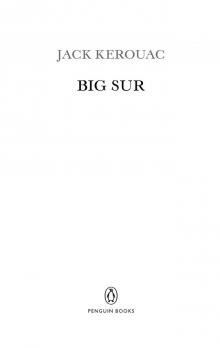 Big Sur
Big Sur Dr. Sax
Dr. Sax Vanity of Duluoz: An Adventurous Education, 1935-46
Vanity of Duluoz: An Adventurous Education, 1935-46 The Sea Is My Brother
The Sea Is My Brother The Town and the City: A Novel
The Town and the City: A Novel Atop an Underwood: Early Stories and Other Writings
Atop an Underwood: Early Stories and Other Writings Desolation Angels: A Novel
Desolation Angels: A Novel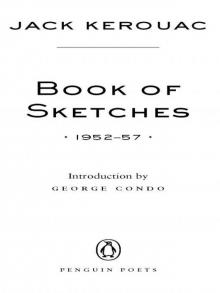 Book of Sketches
Book of Sketches Wake Up: A Life of the Buddha
Wake Up: A Life of the Buddha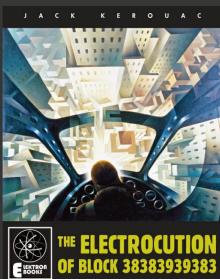 The Electrocution of Block 38383939383
The Electrocution of Block 38383939383 Haunted Life
Haunted Life Visions of Gerard
Visions of Gerard Orpheus Emerged
Orpheus Emerged Book of Blues
Book of Blues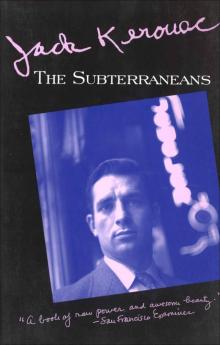 The Subterraneans
The Subterraneans The Haunted Life
The Haunted Life The Unknown Kerouac
The Unknown Kerouac The Town and the City
The Town and the City Visions of Cody
Visions of Cody Atop an Underwood
Atop an Underwood Lonesome Traveler
Lonesome Traveler Jack Kerouac and Allen Ginsberg
Jack Kerouac and Allen Ginsberg Vanity of Duluoz
Vanity of Duluoz Desolation Angels
Desolation Angels On the Road: The Original Scroll: (Penguin Classics Deluxe Edition)
On the Road: The Original Scroll: (Penguin Classics Deluxe Edition) The Sea Is My Brother: The Lost Novel
The Sea Is My Brother: The Lost Novel Wake Up
Wake Up The Poetry of Jack Kerouac
The Poetry of Jack Kerouac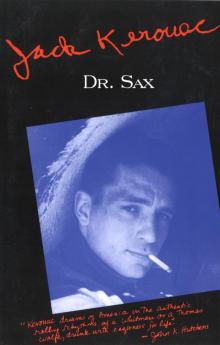 Doctor Sax
Doctor Sax